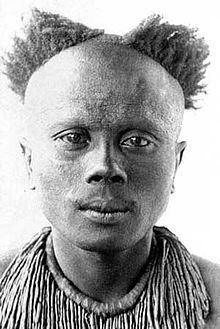 Riala, an interpreter for the British from the Aka-Kede Tribe of Great Andamanese from Middle Andaman, in 1890 | |
| Total population | |
|---|---|
| 59 (2020)[1] | |
| Regions with significant populations | |
Andaman and Nicobar Islands (Strait Island) | 59 |
| Languages | |
| originally Great Andamanese languages, today mainly Hindi and other Indian languages, Census of India 2001 | |
| Related ethnic groups | |
| Onge, Jarawa, Jangil, Sentinelese | |
The Great Andamanese are an indigenous people of the Great Andaman archipelago in the Andaman Islands. Historically, the Great Andamanese lived throughout the archipelago, and were divided into ten major tribes. Their distinct but closely related languages comprised the Great Andamanese languages, one of the two identified Andamanese language families.[2]
The Great Andamanese were clearly related to the other Andamanese peoples, but were well separated from them by culture, language and geography. The languages of those other four groups were only distantly related to those of the Great Andamanese and mutually unintelligible; they are classified in a separate family, the Ongan languages.[citation needed]
They were once the most numerous of the five major groups in the Andaman Islands with an estimated population between 2,000 and 6,600, before they were killed or died out due to diseases, alcohol, colonial warfare and loss of hunting territory. Only 52 remained as of February 2010;[3] by August 2020 there were 59. The tribal and linguistic distinctions have largely disappeared, so they may now be considered a single Great Andamanese ethnic group with mixed Burmese, Hindi and aboriginal descent.[4][5][6]
- ^ Ellis-Petersen, Hannah (27 August 2020). "Ten in remote Indian tribe of 59 test positive for Covid-19". The Guardian. Retrieved 28 August 2020.
- ^ "Jarawa: The Great Andamanese". Survival International. Archived from the original on 12 October 2014.
The Great Andamanese were originally ten distinct tribes, including the Jeru, Bea, Bo, Khora and Pucikwar. Each had its own distinct language, and numbered between about 200 and 700 people. They are now collectively known as the Great Andamanese.
- ^ "Language lost as last member of Andaman tribe dies". The Daily Telegraph. 5 February 2010. Retrieved 3 January 2017.
- ^ Cite error: The named reference
weber7was invoked but never defined (see the help page). - ^ Abbi, Anvita (2006). "Great Andamanese Community". Vanishing Voices of the Great Andamanese. Retrieved 12 July 2012.
- ^ "VOGA". Vanishing Voices of the Great Andamanese.